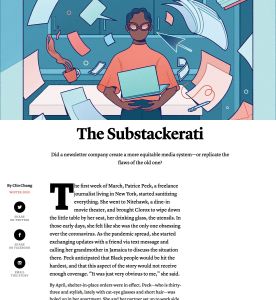Join getAbstract to access the summary!

Join getAbstract to access the summary!
Clio Chang
The Substackerati
Did a newsletter company create a more equitable media system – or replicate the flaws of the old one?
Columbia Journalism Review, 2020
What's inside?
Paid newsletters may be the new journalism frontier, but is Substack the way to go?
Recommendation
The Substack company offers freelance writers a new forum for generating income even as traditional media companies are cutting newsroom jobs. Some freelancers find they can produce newsletters on Substack that generate a meaningful income. However, this new journalistic pathway has limits. Substack itself states that it is only a “platform,” not a “publisher,” however, it intends to provide an infrastructure for writers who publish on its site. Anyone can start a newsletter, though the successful writers Clio Chang cites in her article in the Columbia Journalism Review are primarily white and male, with large, active Twitter followings – thus exemplifying current trends.
Summary
About the Author
Brooklyn freelance journalist Clio Chang writes about politics, culture and media.

















Comment on this summary